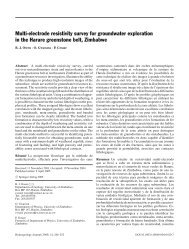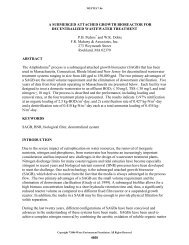Species diversity in the Florida Everglades, USA - Environmental ...
Species diversity in the Florida Everglades, USA - Environmental ...
Species diversity in the Florida Everglades, USA - Environmental ...
Create successful ePaper yourself
Turn your PDF publications into a flip-book with our unique Google optimized e-Paper software.
272 M. T. Brown et al. Ecosystem bio<strong>diversity</strong> <strong>in</strong> <strong>the</strong> <strong>Florida</strong> <strong>Everglades</strong><br />
Transformities Tr1 Tr2 … Trn<br />
To From Solar Emergy Comp. 1 Comp. 2 … Comp. n Constra<strong>in</strong>ts<br />
Comp. 1 - P1 Comp1 (Flowsi*Tri) = 0<br />
Comp. 2 C1 -to- C2 - P2 Cn -to- C2 Comp2 (Flowsi*Tri) = 0<br />
… … …<br />
Comp. n C1 -to- Cn C2 -to- Cn - Pn Comp3 (Flowsi*Tri) = 0<br />
Pi values are total component production m<strong>in</strong>us respiration<br />
Ci -to- Cj values are energy transfers from comp. i to comp. j<br />
It follows that an ecosystem Shannon <strong>diversity</strong> <strong>in</strong>dex<br />
(follow<strong>in</strong>g Eq. 1) is:<br />
Bio<strong>diversity</strong> = – j<br />
Σ<br />
i = 1 EIVi *log[EIVi] (4)<br />
The maximum possible value for this <strong>in</strong>dex occurs when<br />
<strong>the</strong> emergy on each pathway, and <strong>the</strong>refore each component’s<br />
EIV, is equal.<br />
A deviation from Hmax for <strong>the</strong> conventional application<br />
of <strong>the</strong> Shannon <strong>in</strong>dex <strong>in</strong>dicates some degree of<br />
dom<strong>in</strong>ance structure <strong>in</strong> <strong>the</strong> community. When physical<br />
fl ows are adjusted for quality, fl ow evenness across all<br />
ecosystem components is expected; <strong>in</strong>deed, it is <strong>the</strong> postulated<br />
goal condition for network systems that are maximiz<strong>in</strong>g<br />
power (Odum, 1994). Across all components <strong>in</strong> a<br />
healthy ecosystem, <strong>the</strong>refore, we expect to see no association<br />
between emergy throughput and trophic level. We<br />
<strong>the</strong>refore use <strong>the</strong> fractional <strong>diversity</strong> <strong>in</strong>dex (observed <strong>diversity</strong>:<br />
maximum <strong>diversity</strong>) as a measure of an ecosystems<br />
condition. It is also <strong>in</strong>formative to see which particular<br />
components deviate from <strong>the</strong> expected importance.<br />
To measure this deviation from expectation, we compute<br />
a ratio between expected and observed emergy throughput<br />
(EOET) for each component:<br />
TET / N<br />
EOET i = (5)<br />
NP i *r i<br />
where TET is total emergy throughput <strong>in</strong> <strong>the</strong> entire system,<br />
N is <strong>the</strong> number of biotic compartments and NP and<br />
τ are as <strong>in</strong> Eq. 3. The result<strong>in</strong>g values are natural log<br />
transformed to l<strong>in</strong>earize <strong>the</strong> response; consequently, values<br />
larger than 0 <strong>in</strong>dicate a component less important<br />
than <strong>the</strong> expected value of 1 (i.e., equal emergy fl ows on<br />
all network pathways). EOET values were compared<br />
qualitatively with normative judgments of species importance<br />
(e.g., conservation value), and systematic variability<br />
<strong>in</strong> EOET values (e.g., association with transformity<br />
or trophic level) was exam<strong>in</strong>ed us<strong>in</strong>g regression<br />
analysis.<br />
Results<br />
Objective Contra<strong>in</strong>ts = 0<br />
Figure 6. Schematic of <strong>in</strong>put/output matrix form. Transformity values (top row) represent unknowns <strong>in</strong> <strong>the</strong> simultaneous equations defi ned<br />
by <strong>the</strong> constra<strong>in</strong>ts. For fully specifi ed systems (i.e. # equations = # unknown transformities) <strong>the</strong> objective function is redundant.<br />
Transformity values for <strong>the</strong> gram<strong>in</strong>oid a system are given<br />
<strong>in</strong> Table 11. These values represent an average between<br />
wet and dry seasons. While <strong>the</strong>re was a strong correlation<br />
between seasons (r = 0.81) (Fig. 7), higher transformities<br />
were observed <strong>in</strong> <strong>the</strong> wet season co<strong>in</strong>cident with greatly<br />
<strong>in</strong>creased emergy <strong>in</strong>put without commensurate response<br />
<strong>in</strong> biomass production (5.2 × 10 11 and 1.3 × 10 11 sej/m 2 /yr<br />
for wet and dry, respectively; contrasted with primary<br />
production of 6.27 × 10 3 g C/m 2 /yr <strong>in</strong> <strong>the</strong> wet season vs.<br />
3.47 × 10 3 g C/m 2 /yr <strong>in</strong> <strong>the</strong> dry season).<br />
Table 12 summarizes quality-adjusted <strong>diversity</strong>, <strong>the</strong><br />
<strong>the</strong>oretical maximum <strong>diversity</strong> and <strong>the</strong> relative <strong>diversity</strong><br />
as a percent of maximum for <strong>the</strong> gram<strong>in</strong>oid marsh. We<br />
observe that <strong>the</strong> marsh ecosystem is operat<strong>in</strong>g at 42 % of<br />
its maximum potential <strong>diversity</strong>.<br />
Figure 8 shows that as component transformities <strong>in</strong>crease,<br />
<strong>the</strong> Expected-to-Observed Emergy Throughput of<br />
a component becomes <strong>in</strong>creas<strong>in</strong>gly small relative to <strong>the</strong><br />
expected value, thus yield<strong>in</strong>g a higher EOET ratio; <strong>the</strong><br />
Figure 7. Seasonal association of computed component transformity<br />
values. Transformity values are consistently higher <strong>in</strong> <strong>the</strong> wet<br />
season (Pr [slope = 1.0] < 0.001), dur<strong>in</strong>g which emergy <strong>in</strong>fl ows are<br />
substantially <strong>in</strong>creased.
















